

 The South African
The South African
The genesis for this article was the discovery of a group of British medals for campaigns in the late 19th and early 20th centuries, with a strong Southern African bias:

S B Lane’s Medal group -
The two colour photographs were on the back cover
while the text contained black and white versions.
British South Africa Company Medal (reverse Matabeleland 1893) to 1894 Pte S. Lane C.M.R.,
Queen's South Africa Medal (with clasps Tugela Heights, Defence of Ladysmith,
Laing's Nek and Belfast) and
King's South Africa Medal with two clasps to Cl. Sjt. S. Lane Natal Police;
the Natal Medal with clasp 1906 to 1 Cl.Sjt. S. Lane Natal Police; and finally
a 1914/15 Star Trio. The Star is named to Lt. S.B. Lane RAND
INTELL and the War and Victory Medals to 2nd Lt. S.B. Lane.
It seems likely that Lane's medal group is unique. Only 37 British South Africa Company Medals for 1893 were awarded to the Cape Mounted Rifles. While the Cape Police saw extensive service in the South African War, as set out in the article, only eleven members received the King's Medal with both clasps. Despite having made extensive enquiries, no collectors found by the authors admit to having seen a 1914/15 Star to the Rand Intelligence and it seems likely that only around thirty suchmedals were ever issued.
Lane's medal group has a number of interesting facets. While the Natal Police served throughout the South African War, the criteria for the award of the King's South Africa Medal, meant that only 11 members of the Police received it with both clasps. Additionally, in his pre-First World War service, Lane had a distinguished record, having been Mentioned in Despatches by Lord Kitchener on 8 December 1901 "for excellent work in defence of a convoy."
Sampson Beamish Lane, a son of the Anglo-Irish gentry, like many of his type and time, went to make his fortune in Southern Africa towards the end of the 19th century. As his medals attest, Lane served for many years in a variety of units and wars, including in German South West Africa (GSWA) 1914-1915 as part of the Rand Intelligence Corps.
What was the Rand Intelligence Corps?
It does not feature in G Tyndal's The Armed Forces of South Africa, nor other obvious unit histories of the Union, and how many more of these unknown units are there?
The Rand Intelligence Corps
The Rand Intelligence Corps (RIC), officially the 7th Intelligence Unit, was a short-lived unit formed almost immediatelyon the outbreak of war, and after a few months of confused service in GSWA,disbanded with some having faced a court martial, some transferred to other units and others discharged. At heart was a pay dispute, linked to the conditions of enlistment, the records of which allow us to compile this history.

The inscription which led to this article
Like much of the rest of the British Empire South Africa at the start of the 1914 war had to improvise on mobilisation and create forces from scratch. This is reflected in the records relating to the Rand Intelligence Corps. A number of undated formal enrolment forms exist, for instance for Alfred Flynn who signed a form enlisting for four years. The men were later to claim that they only enlisted for six months - some signed the four-year attestation form but this, according to the men, was merely because no other stationery was available. Other enlistments were made on hand-written pieces of paper, such as that for A.J.B. Long, an experienced soldier who had served in the Cape Mounted Rifles as an artillery man and Maxim gunner. He had also served in the Protectorate Regiment in the siege of Mafeking and later as a Scout. Afterwards he served in the South African Constabulary. Long's service mirrors Lane's, suggesting that many who enlisted in the Corps were useful, experienced men who could handle intelligence work.
Recruitment was handled by Captain P.H. Lazarus who was a permanent officer in the UDF and had served in the Field Intelligence Department during the 1899-1902 war, being awarded the King's South Africa Medal with Clasps 'South Africa 1901' and 'South Africa 1902'. His office was in the Johannesburg Stock Exchange at Hollard Street, suggesting recruits were businessmen or traders. Lazarus was assisted by Lt William Thesselton Blissett and Lt Alfred Douglas Brash, who had been employed by the Portuguese government as a curator in Johannesburg.
The unit seems to have been formed on 24th August 1914 with its members having enlisted in the previous week. The unit comprised:
The roll, consisting of 51 names, shows 17 were either Civil Servants or only served briefly, thus they neither qualified for medals or a financial bonus. The requirement for a medal was service in the field of seven months or 244 days. From the surnames of those serving, this was an 'English' unit, with few obviously Boer/ Afrikaans surnames. A number in the unit were of Jewish faith or heritage (Lazarus, [two] Isaacs, Bernstein and Zimmerman as examples), representing South Africa's diverse cultural makeup.
On 24 August 1914, the Corps was mobilised at Booysens, Johannesburg, where the men underwent training. The Corps, part of the Active Citizens Force (ACF), where personnel had to be under 50 years of age to enlist and service was for four years, covered military Districts 5 and 6. Lane was commissioned into the ACF on 21 August 1914 and Brasch on 25 August 1914. Alongside the urban ACF intelligence units was the Rural District Intelligence, which undertook scouting reconnaissance duties. The Corps officers were appointed on 7 September 1914 and after completion of their training, the RIC moved to Rondebosch, Cape Town and then between 11 and 15 October relocated to Lüderitzbucht where it formed part of the Central Force under command of Brigadier General Duncan McKenzie. In November 1914, the RIC was reorganised and attached to D Squadron of the Imperial Light Horse as a composite unit. This caused deep discontent amongst the men who believed they were not being used forthe service for which they had been recruited. They were meant to be scouts. A consequence of this was the resignation of Lazarus, who McKenzie felt was 'unfitted to lead men in action'. If Lazarus had not resigned, on 27 December 1914, he would have faced dismissal for his performance in commanding an attack. When Brasch was also removed from the corps, Lazarus claimed this was due to McKenzie's 'anti-Jewishness'. Brasch moved, on 25 December 1914, to the Imperial General Corps (IGC) as Landing Officer. He was eventually released, demobilised, on 13 September 1915.
With the removal of both Lazarus and Brasch, Lane effectively took command of the unhappy RIC, now only 36 men strong. In February 1915, Lane notified the authorities, that with four exceptions his men were all seeking a discharge, believing that their time was expired. A few days later, on 15 February the men wrote that after the 24th they would not perform duties as they were time expired. This was drastic action for the men had since 12 November attempted to get clarification of their position, even trying between 12 and 25 of that month to get an interview with McKenzie himself. Eventually, on 26 March 1915, the Corps refused duty as they had received no reply to their grievances. On arrival at Lüderitzbucht, they were arrested and charged with mutiny or disobeying an order. Following legal advice, most returned to duty and the charges were withdrawn. As individuals they had claimed discharge under Section 24 Chapter 26 (1914 edition King’s Regulations, p. 198).
It is from the subsequent legal proceedings that we learn that the men believed they had only enlisted for six months at a rate of 15/-per diem. This had been promised by Commandant General Christian F. Beyers, head of the UDF, before he went into rebellion. This was all agreed verbally and by the time the issue came to the fore, Beyers had drowned in the Vaal River. The men had never officially been attested, there are no witnesses to their signing the enrolment forms and no medicals were conducted before the men went to GSWA. Two men were court martialled, Sergeant Evans for refusing to serve more than six months and Sampson Beamish Lane on 11 March 1915. His commission was terminated on 29 March 1915, the Medal Roll noting 12 April 1915 as his demobilisation date.
The court martial does not appear to have adversely impacted Lane. For much of 1915 he remained in South Africa, continuing to harass the authorities with demands for pay. However, he then travelled to Britain and was commissioned into the Royal Field Artillery on 18 November 1915, his Medal Index Card showing that he served in France and Flanders from 1916. His personnel card at SANDF Documentation Centre, shows he moved to the Reserve Brigade Artillery in Ipswich, UK, then to 15th Division, B Battery, 7th Brigade Royal Field Artillery with whom he served 20 months in France. He was subsequently Camp Commandant of the Divisional Artillery Camp for two months whilst in France and was later allocated to A Battery, 326 Brigade, Dublin where he remained until the end of the war. He had served at Loos in 1916, Somme 1916-17, Arras 1917, and Ypres 1917. In 1929 Lane was still trying to obtain a pension.
Conclusions
Other than the termination of Lane's commission, there is nothing on Lane's military record to show he was court martialled. However, there is a medical record dated 10 March 1915 suggesting that Lane 'is in a fit state of health and is able to undergo imprisonment, and with or without hard labour, and that his present appearance and previous medical history both justify this belief, that hard labour employment will neither be likely to originate nor to reproduce disease of any kind'. It is also clear the South African military authorities were aware of his later enlistment with the Royal Artillery as all this is noted on the South African records, and his 1914-15 Star was despatched on 11 August 1922.
A letter dated 8 March 1915 from Prime Minister Louis Botha to Minister of Defence Jan Smuts might explain why no further action was taken regarding Lane and why he was permitted to serve without hindrance in a European unit. Whilst Duncan McKenzie had served well in the 1899-1902 war and had commanded the forces in the 1906 Natal uprising, by 1914, aged 45, McKenzie's British-style service was not what the fast-moving Boer War General Louis Botha appreciated or expected in GSWA. Whether battle weary or out of his depth, by March 1915, Botha felt McKenzie 'no longer has the confidence that he should have of his army' and 'does not understand infantry'. Had news of the RIC complaints reached Botha in the north? Did Botha's assessment of McKenzie's leadership exonerate Lane? We might never know. What we do know is that the pay dispute and the campaign for the pension produced extensive correspondence. This included a file of 380 pages, relating to the pay dispute, which is to be found in the South African National Defence Archives in Irene (DC 708 Grp 2, Rand Intelligence) and it is this correspondence together with letters the Governor General (National Archives of SA: SAB GG776/13 2112; URU 235 1044) that allows us to piece together the story of the Rand Intelligence.
About the authors
Dr Anne Samson runs the Great War in Africa Association and has worked extensively on aspects of South African involvement in World War I, including southafricaww1.com.
Robert Coyle is a semi-retired Chartered Accountant. After a successful career in commerce, he is trying to do something worthwhile with his life and pursues a strong interest in colonial African history. He is a Trustee of the Orders & Medals Research Society.
Return to Journal Index OR Society's Home page
South African Military History Society / scribe@samilitaryhistory.org